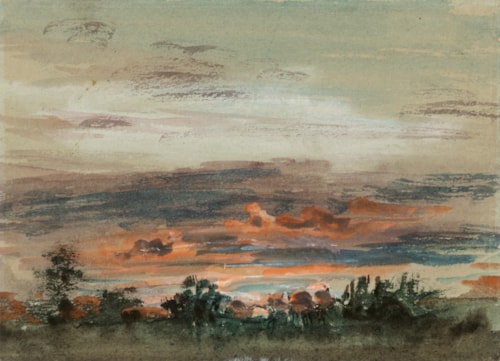
William Henry HUNT
London 1790 - London 1864
Biography
One of the finest British watercolourists of the 19th century, William Henry Hunt was born with a disability, with weak and deformed legs, that prevented him from physical labour, although from his youth he exhibited a talent for drawing that was to lead to a long and highly successful career as an artist. He was apprenticed to John Varley for a period of some seven years, while also studying at the Royal Academy Schools, and became close friends with two of his fellow students in Varley’s studio, John Linnell and William Mulready, with whom he went on sketching expeditions along the Thames. Like Linnell, Hunt was part of the informal drawing academy established by Dr. Thomas Monro, and was able to study Monro’s collection of watercolours. Monro became a close friend of the artist, eventually owning nearly 170 of his works and often inviting him to stay with him at his country home in Bushey in Hertfordshire. It was through Monro that the artist met the 5th Earl of Essex, who in the early 1820s commissioned Hunt to draw the house, grounds and servants at Cassiobury Park, near Bushey. The artist also did the same for another early aristocratic patron and landowner, the 6th Duke of Devonshire at Chatsworth. In general, however, and perhaps due to his infirmity, Hunt did not travel much around Britain, or indeed ever visit the Continent, and was always content to work relatively close to London.
In the early part of his career, between 1807 and 1825, Hunt showed both watercolours and paintings at the Royal Academy, but after his election as an Associate of the Society of Painters in Water-Colours in 1824 and gaining full Membership two years later, he abandoned working in oils to concentrate fully on watercolours. Between 1824 and his death forty years later Hunt exhibited well over 750 works at the Society of Painters in Water-Colours, averaging some twenty-five a year during his most productive years of his career, between 1831 and 1851. (He also showed eleven watercolours at the Exposition Universelle in Paris in 1885.) His oeuvre as a draughtsman included landscapes, rural genre subjects, interior scenes, rustic figure studies, portraits and still life subjects, and his watercolours were widely collected in his lifetime, fetching increasingly higher prices as the years went by.
Among Hunt’s occasional pupils was John Ruskin, who was a lifelong admirer of his work and often mentioned him in his lectures and writings. (Ruskin also hung Hunt’s watercolours alongside those of his idol, J. M. W. Turner, in his bedroom at Brantwood.) The later 1830s found Hunt beginning to move away from landscape subjects towards interior scenes, studies of country folk, and still life subjects, particularly of fruit, flowers and bird’s nests, painted with a particular fineness and delicacy that meant that the artist worked very slowly. Characterized by an often innovative technical mastery, these carefully painted, detailed and highly finished still life subjects proved especially popular with collectors, and earned the artist the sobriquet ‘Bird’s Nest’ Hunt. Hunt’s watercolours were much admired by critics such as Ruskin, who believed him to be the finest still life painter of the period, and F. G. Stephens, and by the 1840s his works were also being engraved.



